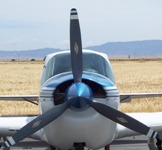|
Best time of the year to go? |
Fall though spring. HOT in
the summer. |
|
Flight time in a Super Viking from KAJO? |
1.2 |
|
Food on the airport? |
Yes, good food too. the
restaurant above the terminal is owned by the same people
who the restaurants at KMHV, KWJF and L71. |
|
Fuel on airport? |
Yes, self serve prices are
usually good. |
|
Landing or Parking fees? |
Fee for overnight. |
|
Comments about arriving and departing. |
Las Vegas approach is real
good about giving class B clearances. |
|
Things to do at or near the airport. |
It's Las Vegas baby! |
|
Rate this stop with 10 being best, 5 average. |
8.0 |
 |
Everyone meeting up, except
John, before the tour. John
Christensen |
 |
The group of Bellanca Super
Viking owners who took the tour. |
 |
The High Scaler on the
Nevada side. |
 |
|
 |
Hoover Dam from the visitor
center
Dewey Elsik |
 |
3/4 level progress on the
dam; August 31, 1934 |
 |
They are four
reinforced-concrete structures located above the dam, two on
each side of the canyon. The diameter of these towers is 82
feet at the base, 63 feet 3 inches at the top, and 29 feet 8
inches inside. Each tower is 395 feet high and each controls
one-fourth the supply of water for the power plant turbines.
The four towers contain 93,674 cubic yards of concrete and
15,299,604 pounds of steel.
John
Christensen |
 |
Intake towers; March 26,
1935 |
 |
Lake Mead overflow
intake structure on the Nevada side. |
 |
The Hoover Dam Bypass under
construction.
Ron Quillin |
 |
This is a very unique
picture as it was taken from inside the dam though an air
grill. (see below)
Ron Quillin |
 |
Taking the picture above
John Christensen |
 |
I have no idea where this
hole went or how far down it goes. I was trying to send Ron
down to find out. Ron Quillin |
 |
What makes the above
picture so unique is how it were taken. Ron Quillin stuck
his arm though the air intake (red arrow) and snapped the
picture two above. |
 |
One of the 30-foot-diameter
penstocks (pipes). In the video you'll se us walking
along side of this pipe. There are 4,700 feet of
30-foot-diameter pipe. Maximum thickness of the largest pipe
is 2 3/4 inches.
Ron Quillin |
 |
More of the 30'
pipe.
John
Christensen |
 |
More of the 30'
pipe.
John
Christensen |
 |
Penstock pipe in fabrication
shop; 1934 |
 |
Section of pipe in transit
to site; 1934 |
 |
House power on the Arizona
side. One of these reside on the Nevada side also. These
were the first generators installed in Hoover Dam John
Christensen |
 |
Paddles used in the house
power generator. I may know the woman who they used for this
mold. John
Christensen |
 |
Ron Quillin |
 |
Ron Quillin |
 |
Generator row on the Inside Hoover Dam,
Arizona side. John
Christensen |
 |
Generator row on the Inside Hoover Dam,
Arizona side. John
Christensen |
 |
John
Christensen |
 |
John
Christensen |
 |
John
Christensen |
 |
A modem gate valve (huge)
is so efficient that one valve replaced 5 needle valves. (see
below) John
Christensen |
 |
This picture was taken from
under the needle valve looking back at the capped of pipes
no longer needed. (see above) John
Christensen |
 |
The Hover Dam Control Room.
John
Christensen |
 |
Water leaving the
generators taken from below. John
Christensen |
 |
Water leaving the generators
taken from above. John
Christensen |
 |
Shaft alley, under the
generators and above the turbines. Ron Quillin |
 |
A close up
of Shaft Alley.
John
Christensen |
 |
Inside Hoover Dam John
Christensen |
 |
Inside Hoover Dam John
Christensen |
 |
Inside Hoover Dam John
Christensen |
 |
|
 |
The Dam from the Arizona
side.
John
Christensen |
 |
Across to the Nevada side.
John
Christensen |
 |
|
 |
150 man worker transport to
dam site; 1932. This must have been pre OSHA. |
 |
The drawing shows how the completed Hoover Dam works. The
Nevada wall of the Black Canyon (to the left) is shown
solid, but the Arizona wall (to the right) shows with broken
lines what the internal structures behind the wall look
like. The fluted cylinders behind the dam are intake towers,
and pipes leading from them are penstocks. These convey
water to the turbines in the powerhouse at the foot of the
dam. While the dam was being built, the four large tunnels,
two on each side of the river, diverted the river around the
dam site. The upstream ends of these tunnels have been
plugged. They serve as penstocks and spillway outlets. |













